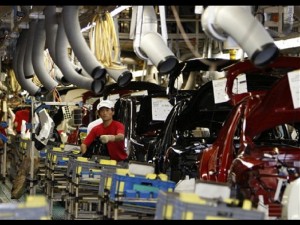Toyota utilizing hybrids to help with power crunch
TOKYO — Toyota’s electric-gasoline hybrid car technology will be utilized to help ease power shortages in Japan’s disaster-struck northeast, part of a set of measures the automaker hopes will underline its commitment to the region.
Toyota Motor Corp. said Tuesday it will donate emergency power supply systems linked to its Prius hybrid cars to prefectures (states) in the Tohoku region ravaged by the March 11 earthquake and tsunami.
The systems will be fitted to about 40 of the automaker’s Prius hybrids. Hybrid vehicles can be used to store and generate electricity because it is partly an electric vehicle that runs on a high-quality battery.
Toyota’s hybrid technology has already been helping in quake-affected areas, which suffered massive blackouts, as an emergency source of electricity.
The automaker said the positive reviews for its Estima hybrid minivan, which comes with regular electrical outlets to plug in and run household appliances for up to two days, are prompting it to make it available as an option for the Prius within a year.
Toyota also announced Tuesday that it will set up a manufacturing training school in the northeast, hoping to send home the message it remains committed to making cars in Tohoku and Japan overall despite mounting obstacles.
Fears are growing that Toyota and other major manufacturers may move production abroad after the tsunami and earthquake left key suppliers in a shambles, disrupting production.
Another setback are the meltdowns at a nuclear power plant, which is crimping the electricity supply and forcing manufacturers to cut back on electricity use.
Recruiting for the new technical school for high school graduates and employees of Toyota affiliates in the northeast will start in July next year. The first class for 10 to 30 students will begin in April 2013, the world’s largest automaker said in a statement.
Toyota also said it will donate 300 million yen ($3.8 million) for educational help for children, many who lost their parents in the disaster, and another 3 million yen ($38,000) to support the arts in Tohoku.
Last week, Toyota announced it was consolidating its operations among Tohoku group companies, and strengthening research and development in the region to make it Toyota’s third production center in Japan — after its headquarters in central Japan and Kyushu, southwestern Japan.
One vehicle set to be produced in north-eastern Japan is a small hybrid that’s a key part of Toyota’s line-up of green vehicles, according to the automaker.
Other Japanese automakers are also eyeing renewable energy as a business opportunity, taking advantage of the power-generating feature of green cars.
Nissan Motor Co. is testing a super-green way to recharge its Leaf electric vehicle using solar power. Honda Motor Co. already has solar panel and home power generating businesses that it is planning to strengthen as interest grows in renewable energy because of the nuclear crisis.
